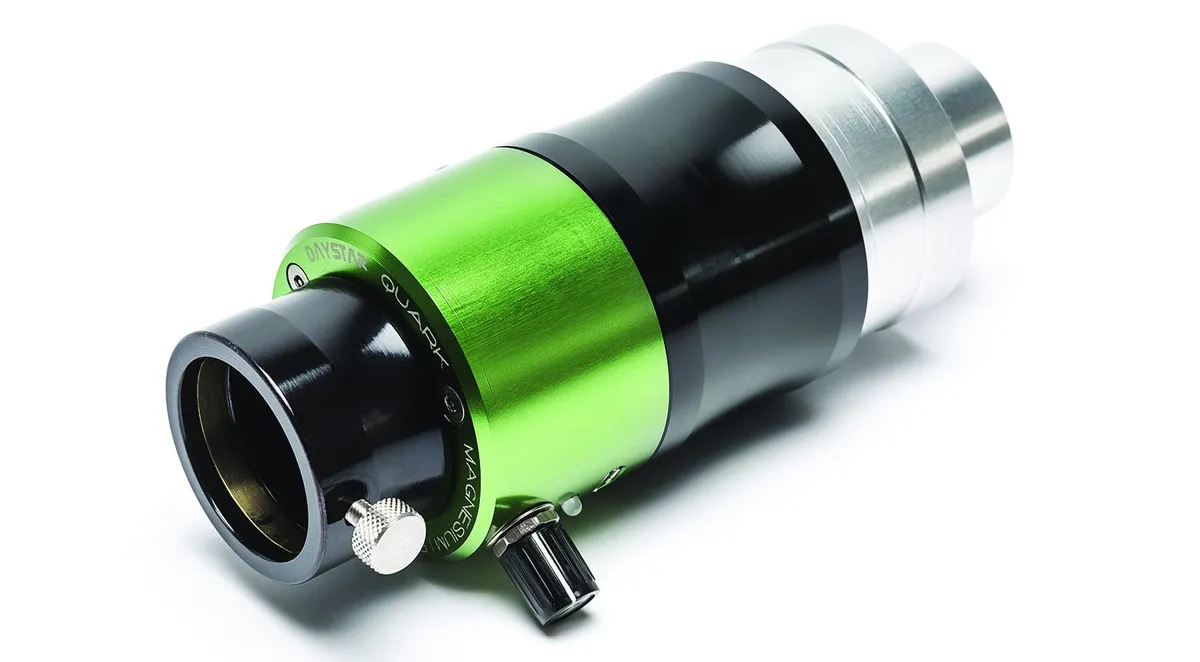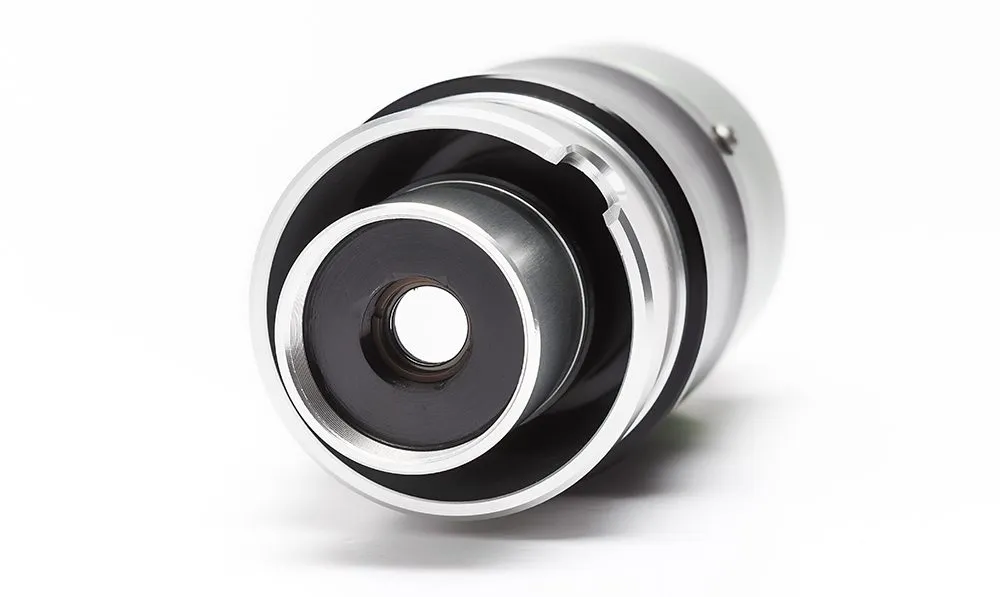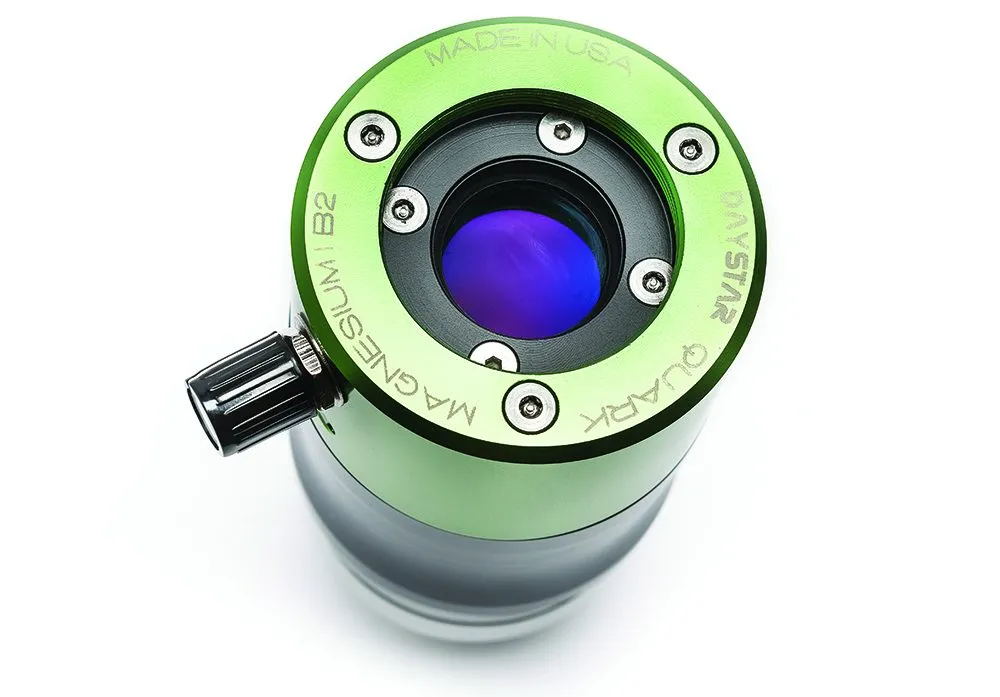DayStar has expanded its Quark range of solar eyepieces to include a new wavelength, Magnesium I b2, with some interesting results.Not least of which was that it revealed a entirely new area of interest on the Sun’s disc. But more of that later.
The Quark Magnesium I b2 is designed for use with air-spaced refractor telescopes ranging from f/4-f/8. It can be used on telescopes up to 120mm with a UV/IR blocking filter attached.
For telescopes above that you will need to contact DayStar about a custom energy rejection filter (ERF) for the front of the telescope as its standard red and yellow ones won’t work with the Magnesium Quark.
The filter has its wavelength set at 5172.8Å giving its views a green hue, and so, naturally, it comes in a green case to designate the wavelength of the Sun it explores.
Following the design of the original Quark it features a built-in 4.2x telecentric Barlow, a 1.25-inch or 2-inch barrel for mounting it to a telescope and a 1.25-inch fitting on the top so you can attach an eyepiece or camera.
A 5V/2A power socket – for heating the filter – and a tuning adjustment knob are both located on the side of the body.
Why the need to heat it up? As DayStar told us: “On all Quarks the heater is to isolate the exact wavelength of the absorption line of the chemical.
"The accuracy of this tuning needs to be incredibly precise, down to the distance between the nucleus and first electron of a molecule.
"At this scale, expansion and contraction of the optical components due to temperature changes the target wavelength."
Want to observe a solar eclipse? Find out when the next eclipse is taking place.

Longer-lasting power
DayStar has made changes to the electronics on this model, reducing the power consumption to allow the unit to run all day on a smaller battery powerpack, a big help if you’re using the Quark out in the field or for outreach events.
Setting the Quark up is quite simple.
For visual uses it can be inserted in a diagonal with a 1.25-inch eyepiece attached.
Turn it on and wait for its indicator light to turn green to show that it’s ready for use; this takes around 10 minutes in average temperatures.
For imaging it works best on a refractor with no diagonal and will normally require an 80mm extension tube in order to reach focus with a camera.
The Sun is currently close to solar minimum which means that sunspots are small and rare at the moment.
The Magnesium Quark shows quite nice detail in and around the sunspots visually, but in our opinion it is better suited to imaging.
Details in plage and facula areas are hard to see with the eye as its images are brighter than those produced by the other Quarks.

A new discovery
We set up a few imaging tests through the review period and were very impressed with the detail seen on the photosphere of the Sun.
The Quark Magnesium seems to reveal a combination of various features seen in other wavelengths.
The first noticeable one was the plage areas normally seen in the calcium model.
While not as defined as it would be through a CaK filter, it was very clear almost to the limb of the Sun.
Looking at other areas we could see granulation that would normally be picked up in the sodium line and the outlines of filaments that resemble the H-alpha and helium views.
This was quite surprising and as we played with the tuning knob we could bring out detail in other areas that we’ve never seen before.
Running a side-by-side test with the calcium, sodium and Ha versions of the Quark revealed an area of interest not visible using the other Quarks.
What made it even more exiting was that when we checked the image with the manufacturer and others, no one really had an answer as to what the feature was – so, an intriguing observation meriting further study.
All the cameras we tried with the Quark Magnesium I b2 worked very well, though we found the best detail was achieved with a mono camera.
Full-disc images can also be achieved using DayStar’s Camera Quark adaptor and a Canon or Nikon lens.
Since its inception, DayStar’s Quark range has allowed us to see the Sun in wavelengths once thought of as exotic because of the previously exorbitant price of the kit.
The Magnesium I b2, which lets us look into the Sun in a new way again, is a welcome addition to the line-up.

Internal filter
The Magnesium Quark filter is a leap forward in solar observations.
In the past very little has been documented using this wavelength and any images that were produced suffered from poor quality because of the equipment used.
The I b2-line works well with poor seeing conditions, producing more stable images than other wavelengths, such as calcium, that need very stable conditions to image at high resolution.
The resulting structural detail in the images has never been seen before; while Ha images do show some stunning detail, they hide a lot of what’s going on between the photosphere and the chromosphere.
This filter can see highly magnetised areas close up and, we felt, showed more detail than the calcium and sodium Quarks.
Even at a solar minimum the filter excels at finding new areas of interest and study.
It’s left us looking forward to when the Sun becomes more active.
Power port
The Quark comes with a mains supply with a 1.5A output.
This means lots of other power supplies won’t work with it and the light will stay orange.
For use in the field or away from a mains supply an optional battery pack with a 5V/2A output will run the Quark all day.
LED
A coloured LED shows when the Quark has heated to the correct temperature: it’s orange for five to 10 minutes and then goes green when the filter has reached its required temperature and is ready for duty.
Red indicates that not enough voltage is reaching the unit or that there is an electrical fault.
Tuning knob
The tuning knob allows you to fine tune the wavelength from a centre value of 5172.8Å by 0.1A with each click, adding or subtracting levels of detail with each adjustment.
Each time the knob is adjusted the filter will require around 10 minutes to heat or cool.
Barrel
The Quark has been designed to fit on most refractor-based telescopes and comes with a 2-inch and 1.25-inch barrel.
The 2-inch barrel has a cut-out to allow for a more precise 1.25-inch mounting in a diagonal for visual use.
Care must be taken inserting it into some shallow 2-inch diagonals as the Quark is quite long and can touch the internal mirror.
Telecentric Barlow
The Quark has been designed for use on f/4 to f/8 refractors.
With the built-in 4.2x telecentric Barlow this will result in a long focal length varying with the focal length of the refractor used.
This can make objects hard to see or focus on if the Quark is used on equipment with a large aperture.
Vital stats
- Price £1,199
- Barrel size 1.25-inch and 2-inch
- Tuning range Wing shifting +/– 0.5Å Wavelength 5172.8Å
- Power requirement 5V/2A
- Extras Power supply with power lead; protective case
- Weight 400g
- Supplier Widescreen Centre
- Tel:01353 776199
- www.widescreen-centre.co.uk
This review originally appeared in the January 2019 issue of BBC Sky at Night Magazine